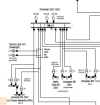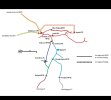thecrofter
Member
- Joined
- 16 Dec 2011
- Messages
- 219
Ah, I see your confusion and yes, that drawing is a tad misleading.
As for Camden TSC, it is one of the original WCML Switchgear & Cowans K11 equipment of 1960's vintage that had cable feeds underneath the substation slab hence no outward signs of it being a connected to the OLE.
As for Camden TSC, it is one of the original WCML Switchgear & Cowans K11 equipment of 1960's vintage that had cable feeds underneath the substation slab hence no outward signs of it being a connected to the OLE.



